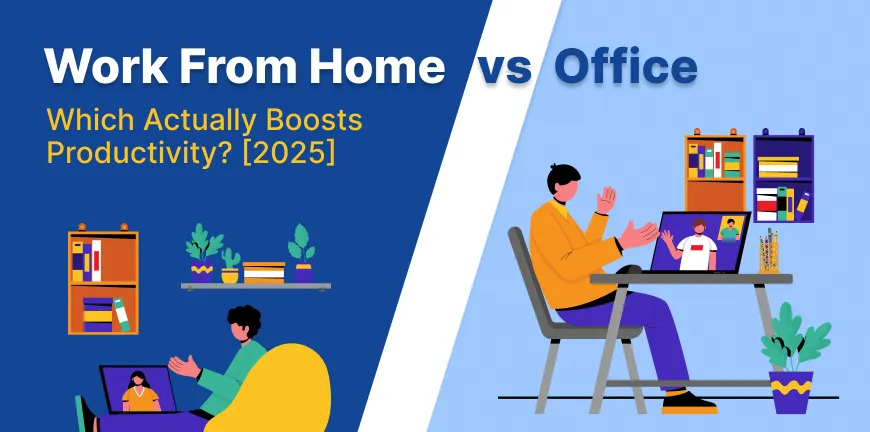
Difference between Resume vs CV – 4 Tips to Write them Effectively
07/10/2025
NATS vs NAPS: Which Apprenticeship Scheme is Right for You?
12/10/2025- What is Work from Home (WFH)?
- What is Work From Office (WFO)?
- 6 Key Factors That Influence Productivity
- What are the Advantages of Work From Home?
- What are the Disadvantages of Work From Home?
- What are the Advantages of Working from the Office?
- What are the Disadvantages of Working from the Office?
- Productivity Comparison: WFH vs WFO
- Is Hybrid Work the Best of Both Worlds?
- Comparison Table
- Key Takeaways
- Conclusion
- Frequently Asked Questions
The work-from-home (WFH) vs work-from-office (WFO) debate continues to reshape modern workplaces, with both employees and employers seeking the ideal balance between productivity and collaboration. While remote work offers flexibility and time savings, office environments strengthen teamwork and culture.
This blog provides a clear, data-driven comparison of both models by examining their advantages, challenges, and long-term implications.
The insights gained through this detailed discussion will help organisations and professionals choose the most effective work setup for sustained success in today’s evolving business landscape.
What is Work from Home (WFH)?
Work From Home (WFH) arrangement lets employees do their jobs from home instead of travelling to a designated office space or premises. This flexible working model enables people to complete their tasks away from regular workplaces by using information technology.
Companies can implement WFH arrangements temporarily, as we observed during the COVID-19 pandemic, or permanently as part of a structured home or hybrid working system. These arrangements vary from part-time to full-time, and occasional to frequent, based on company policies and job requirements.
WFH isn’t new, despite its current popularity. Most work happened at home through family businesses before the Industrial Revolution. Work moved to factories for over 200 years until Information and Communication Technology (ICT) made it possible to work from home again.
Recent data shows that about 22 million American employees (14% of the adult workforce) worked from home in 2024. On top of that, 35% of workers who can do their jobs remotely now work from home full-time.
People often use WFH, telecommuting, and remote work interchangeably, but there are subtle differences between them. WFH means working specifically from your home, while remote work includes working from places like co-working spaces and coffee shops. WFH is actually a type of telework, which also covers work done while travelling.
Jobs that work best for WFH are ones you can do online or on local devices. Common WFH positions include:
- Accountant
- Engineer
- Teacher/Tutor/Instructor
- Writer
- Consultant
Today’s WFH setups depend on digital communication tools like video conferencing, instant messaging, and cloud-based collaboration platforms. These technologies have made remote collaboration easier in industries of all sizes.
What is Work From Office (WFO)?
Work From Office (WFO) is the traditional employment model where employees work at a physical workplace that their employer owns or rents. Staff members work fixed hours in structured environments and stay at the office throughout the day.
The traditional WFO setup has employees commute to a central location. They access company resources, interact with colleagues face-to-face, and work under direct supervision. Moreover, the office space has individual workstations, meeting rooms, and common areas that help with professional activities.
WFO environments make immediate collaboration possible through face-to-face communication. Teams can:
- Get tasks done faster through spontaneous discussions.
- Build stronger work relationships through daily interactions.
- Use shared resources and infrastructure right away.
- Join impromptu problem-solving sessions.
The traditional office setup creates clear lines between work and personal life. This boundary helps employees mentally prepare for their work duties. Unlike remote setups, on-site workplaces usually follow a hierarchy with centralised decision-making.
WFO brings benefits like stronger team unity and better oversight. Research shows that working onsite leads to fewer communication mistakes and gives direct control over operations. Notwithstanding that, this setup faces challenges like higher operational costs and possibly more work-related stress.
Unlike flexible arrangements, the standard office model requires specific working hours, usually 9-to-5. Also, companies that choose this approach value having people physically present. Moreover, WFO helps maintain company culture and makes knowledge sharing easier between team members.
The WFO model dates back centuries but really took off during the Industrial Revolution as work moved from homes to central locations. It remained the main way of working until recent tech advances made other working models possible.
6 Key Factors That Influence Productivity
Several factors influence employee productivity in any work setting. The physical environment is a vital component: studies show employees perform better in offices kept at 25°C compared to 27°C.
1. Leadership Styles
Effective leadership styles can affect output a lot. Research indicates that democratic leadership approaches help maximise productivity. Leaders’ relationships with their teams directly influence quality control and process efficiency.
2. Company Culture
A company’s culture elements, such as handling conflicts, unity, innovation, and clear goals, drive productivity. Companies that build strong cultures see their revenue grow 4 times faster.
3. Employee Wellness
Employee wellness makes a real difference. Better health improves morale, reduces burnout, and stimulates creativity. Moreover, companies with wellness programs see 25% fewer sick days.
4. Training and Development
Training and development skills are the foundations of productivity growth. Companies that provide complete training programs see 218% more income per employee. Managing workloads properly matters too, since overworked employees are 68% more likely to feel stressed.
5. Good Communication
Good communication helps set clear expectations. Companies that communicate well are 3.5 times more likely to outperform their competition.
6. Technology
Technology plays a big role in efficiency. Workers lose about 22 minutes each day because of IT problems. The right tools, regular tech checks, and proper training help reduce these delays.
These factors combine differently when people work from home versus the office. Understanding how they show up in each setting helps determine the best arrangement for your team’s productivity.
What are the Advantages of Work From Home?
Studies show that working from home comes with several benefits that improve productivity and well-being. Here are 6 key advantages of working from home:
1. Work Life Balance
Remote work’s biggest advantage is a better work-life balance. Employees blend their personal tasks with work commitments more easily, which leads to a more balanced lifestyle. This comes from not having to commute anymore. People save almost an hour each day they’d normally spend going back and forth to work.
2. Higher Productivity
People get more work done at home by a lot. Without the usual office distractions and pointless meetings, remote workers focus better on important tasks. This extra concentration helps especially when you have roles that need careful thinking and attention to detail.
3. Better Control Over Tasks
Having more control over your work is another key benefit. Remote employees can take breaks whenever they need to and plan their day around when they’re most productive. They can also set up their workspace just the way they like it, which ended up making them more comfortable and efficient.
4. Substantial Savings
The money savings are substantial, too. Remote workers save about ₹506,282 every year by cutting costs on transport, work clothes, parking, and lunch. Companies also spend less on office space and utilities.
5. Reduced Carbon Footprint
Remote work helps the environment. People who work fully remote can cut their carbon footprint by 54% compared to office workers. Less commuting also means lower carbon emissions and less traffic on roads.
6. Diverse Workforce
Remote work opens doors for a more diverse workforce. Companies can hire talented people, whatever their location, making workplaces more inclusive for people with disabilities, family responsibilities, or other limitations.
These benefits explain why most people say they have more good experiences than bad ones while working from home.
What are the Disadvantages of Work From Home?
Remote work sounds appealing, but it comes with several challenges that affect productivity. Workers often struggle to separate their personal and professional lives when working from home. This blurred boundary creates what many call an “infinite workday”, where employees find it hard to switch off.
1. Loneliness
Loneliness emerges as a major concern since employees miss their daily interactions with colleagues. Research shows remote workers rate missing their coworkers at 3.83 out of 5. The workplace culture feels distant to many employees working from home.
2. Distractions
Distractions at home can seriously disrupt focus and workflow. The TV tempts 32% of remote workers, while 27% struggle with childcare duties. These interruptions make it harder to maintain consistent productivity throughout the day.
3. Improper Ergonomics
Many homes lack proper office setups and ergonomic furniture. Remote workers rate their physical workspace conditions at just 3.06 out of 5. Poor setups lead to health issues from bad posture and limited movement.
4. Security Risks
Security risks increase when employees access company data from different networks. Some workers become relaxed with security protocols, which creates weak points in the company’s defences.
5. Miscommunication
Quick feedback and spontaneous teamwork suffer in remote settings. Team members can’t walk over to their colleague’s desk for immediate input, which leads to delayed responses and missed opportunities for collaboration.
6. Higher Setup Cost
Setting up a home office brings its own financial burden. Workers need to buy equipment, pay higher utility bills, and invest in creating an appropriate workspace.
What are the Advantages of Working from the Office?
Traditional offices give productivity advantages that remote work can’t match. Face-to-face collaboration is the lifeblood of office culture. People spark creativity and solve problems quickly through spontaneous interactions. Team members learn faster through immediate feedback and mentoring.
1. Clear Separation Between Professional and Personal Life
The physical office creates a clear line between work and personal life. Employees can switch off mentally when they leave the building, which reduces their risk of burnout. The office environment provides a structured routine that helps many people stay focused.
2. Better Collaboration with Colleagues
Building professional relationships at work is a vital part of office life. Daily interactions build trust and friendship beyond work tasks. Yes, it is proven that workplace connections boost employee performance by up to 37% and retention by 36%.
3. Better Facilities
Offices come equipped with resources you won’t find at home. High-speed internet, advanced technology, and well-equipped meeting spaces help work move faster. Privacy becomes another advantage, especially for companies that handle sensitive information.
4. Better Work Culture
Working onsite strengthens your connection to company culture. Physical presence lets employees experience organisational values directly, which builds belonging and dedication. This community spirit helps curb isolation. Statistics show 34% of employees now choose to spend time with coworkers in the office—more than before the pandemic.
What are the Disadvantages of Working from the Office?
Working in an office has major drawbacks that affect employees’ well-being and how well they perform.
1. Longer Commute Time
The daily commute tops the list of disadvantages. Workers spend about 54.2 minutes each day just getting to and from their offices. This adds up to almost 19 days a year wasted on travel alone.
2. Higher Expenses
Money is another big concern. Office workers don’t just pay for commuting – they need professional clothes, parking spots, and often buy lunch at work. These costs pile up to roughly $4,000 each year for a typical employee.
3. Work Schedules Can Take a Toll
The strict office schedules make life harder. Workers struggle to fit in doctor’s visits, take care of family needs, or handle unexpected situations. This lack of flexibility creates more stress for people working in offices.
4. Restricted Workspace
The office space itself gets in the way of getting work done. Research shows office workers get interrupted every 11 minutes, but need 23 minutes to get back into their work properly. Most of these interruptions come from unexpected meetings, coworkers chatting, and general office noise.
5. Higher Chances of Disease Transmission
Health issues are a vital concern in office settings. Shared air in enclosed spaces makes it easier for illnesses to spread, which often results in more sick days. Long hours of sitting under artificial lights also cause physical strain and tiredness.
6. Negative Impact on the Environment
The environment takes a hit too. Each office worker’s daily commute adds about 3.2 tons of CO2 to the atmosphere yearly through transportation alone. This makes office work, among other factors, that harm our environment.
Productivity Comparison: WFH vs WFO
Research shows some surprising contrasts when looking at productivity metrics between remote and office settings. The work-from-home vs. work-from-office productivity debate has become more complex with newer studies.
Research consistently shows that remote workers achieve 35-40% more productivity than their office-based colleagues. They make 40% fewer mistakes and give back 40% of their commute time to their employers. Quiet work environments and fewer breaks helped remote workers achieve a 13% productivity boost.
Some studies tell a different story. A detailed study showed an 8-19% reduction in productivity when people worked from home. Workers put in longer hours but got less done per hour.
Office settings come with their own challenges. UC Irvine researchers found that office workers get interrupted once every 11 minutes and need 25 minutes to get back into focus. These constant disruptions substantially affect their ability to complete tasks.
Remote work has shown promising results. 77% of employees who work remotely sometimes say they get more done, and 30% complete more work in less time. Communication patterns also matter: 64% of workers say they’re most productive when they can communicate on their own schedule.
Job type plays a crucial role in where work gets done best. Routine tasks see better results in office settings, while creative work runs in home environments. These findings show that productivity depends on each person’s role, job needs, and company culture rather than following a one-size-fits-all approach.
Is Hybrid Work the Best of Both Worlds?
Hybrid work models offer a practical solution to the ongoing debate between working from home and the office. Employees can now split their time between remote and in-office work. This creates a flexible schedule that builds on the advantages of both environments.
Recent studies show that 49% of workers prefer this balanced approach over working exclusively from home or the office. This middle-ground solution tackles several key challenges that traditional models don’t deal very well with:
- Strong team connections and shared work with fewer commutes.
- A thriving company culture through face-to-face interactions.
- The freedom to focus on individual tasks at home.
- Better separation between work and personal time.
Hybrid arrangements help boost employee satisfaction because you retain control over your work environment. Companies that adopt hybrid policies usually set specific “collaboration days.” Teams come together in the office these days to meet, brainstorm, and build relationships.
Hybrid work needs careful planning to decide which tasks happen where. You might schedule deep focus work for home days. Complex problem-solving and creative teamwork often work better in person.
The office has evolved from a daily requirement into a destination with purpose. People come together there for specific shared activities. This balanced approach could shape the future of modern work arrangements.
Comparison Table
| Aspect | Work From Home (WFH) | Work From Office (WFO) |
| Productivity Statistics | • Workers show 35-40% higher productivity than office counterparts • Staff make 40% fewer errors • 77% of employees report better output | • Staff faces an interruption every 11 minutes • Each interruption needs 23 minutes to regain focus |
| Cost Impact | • Each employee saves ₹506,282 yearly on travel, clothes, and food • Home utilities cost more | • Personal expenses rise with travel, work clothes, parking, and meals • Personal costs reach about $4,000 per year |
| Time Management | • Employees save 1 hour daily without commuting • Schedule flexibility | • Daily commute takes 54.2 minutes • Standard 9-to-5 schedule |
| Collaboration | • Team responses take longer • Less casual interaction • Virtual meetings present challenges | • Quick face-to-face problem solving • Natural team discussions • Teams bond better |
| Work Environment | • Personal workspace control • Some ergonomic challenges • Home life can distract | • Professional office setup • Full resource access • Office noise can interrupt work |
| Well-being | • Life and work balance better • Some feel isolated • Work hours blur with personal time | • Work-life boundaries stay clear • Strong social connections • Fixed schedules create more stress |
| Environmental Impact | • Carbon footprint drops by 54% • Less travel means fewer emissions | • Carbon emissions increase • Each worker adds 3.2 tons of CO2 yearly from travel |
| Employee Preference | 26% want full remote work | 25% prefer office work |
Key Takeaways
- Remote workers show 35–40% higher productivity, but results vary based on job type and setup.
- Office environments boost collaboration, mentorship, and company culture through real-time teamwork and direct communication.
- Hybrid work offers the ideal balance, flexibility, focused productivity, and essential in-person interactions.
- Cost savings and environmental benefits make remote work attractive for both employees and employers.
- The future of work depends on adaptable workforce strategies that align with the evolving needs of both businesses and employees.
Conclusion
The debate between work-from-home, office, and hybrid models shows that there’s no universal solution, only smart adaptation. Each setup offers unique productivity, cost, and cultural benefits. The key is building a workforce strategy that fits your business goals. ALP Consulting helps companies design flexible, scalable workforce solutions, from hybrid staffing to project-based hiring, ensuring you have the right talent in the right place, every time.
Frequently Asked Questions
1. What are the current trends in remote work for 2025?
As of 2025, about 36% of new job postings are for hybrid or fully remote positions. While some companies are pushing for a full office return, experts predict that hybrid work models will continue to be prevalent due to their ability to attract talent and boost productivity.
2. How does productivity compare between working from home and in the office?
Studies show that remote workers are 35-40% more productive than their office counterparts. However, productivity can vary depending on the nature of the work and individual preferences.
3. What are the main advantages of working from home?
Working from home offers several benefits, including improved work-life balance, elimination of commute time, potential cost savings, and the ability to create a personalised work environment.
4. What challenges do people face when working from home?
Common challenges of remote work include feelings of isolation, difficulty separating work and personal life, potential distractions in the home environment, and reduced face-to-face collaboration with colleagues.
5. Is a hybrid work model the best solution for most companies?
A hybrid work model, which combines remote and in-office work, is gaining popularity as it can offer the best of both worlds. It allows for flexibility and focused work at home while maintaining in-person collaboration and team building.




